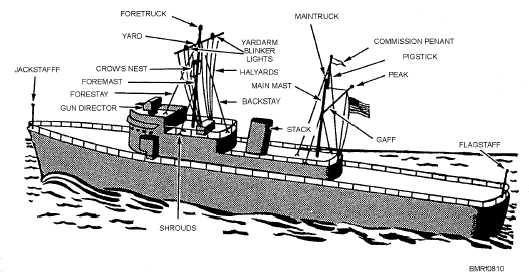Masts are used to support radio and radar antennas,
signal halyards (lines used for hoisting signal flags
signal lights, and booms). Stays and shrouds, together
with other wires used for similar purposes on stacks,
masts, and so on, are known as the ship’s standing
rigging. Lines or wires used for hoisting, lowering, or
controlling booms, boats, and so on, are known as
running rigging.
Look at figure 8-10. The top of a mast is called the
truck. A small sheave (a pulley, pronounced shiv) at
the truck is used to run halyard lines for hoisting. The
top of the foremast is the foretruck, and the top of the
main- mast is the main truck. Commissioned ships of
the U.S. Navy fly a commission pennant secured to a
pigstick and hoisted to the truck. Ships that have radar
antennas at the top of their masts fly the commission
pennant from a sheave fixed in the highest convenient
location.
Most foremasts have a light spar, called a yard, and
mounted horizontally athwartships on their upper part.
The port and starboard halves of a yard are the port and
starboard yardarms. The yardarms carry a number of
sheaves for signal halyards. Also, yardarms usually
carry a set (two) of blinker lights, used (by means of a
telegraph key) for signaling. The gaff is a light spar
suspended at an angle abaft the upper part of the
mainmast. The upper end of the gaff is the peak. The
national ensign is flown at the peak while a ship is under
way. When a ship is anchored or moored, the national
ensign flies from the flagstaff at the stern, and the union
jack flies from the jackstaff at the bow.
The bridge, from which the ship is controlled
while under way, is located in the superstructure. The
bridge contains the primary equipment used by the
bridge watch personnel to control (conn) the
movement of the ship: helm (steering control), lee
helm (speed control), and radar repeaters. Ships also
have a secondary conning station from which control
can be maintained if the bridge is put out of
commission. Some larger classes of ships have, in
addition to the navigation bridge (conn), a flag bridge
for the use of the squadron commander or admiral and
staff.
The signal bridge (where Signalmen operate the
signal lights, flags, and pennants) is normally located
atop the bridge. On aircraft carriers, the signal bridge is
abaft and usually one deck above the navigation bridge.
Outboard, open ends of a bridge are called bridge wings.
Located near the bridge is the chart house, where charts
(maps) are stowed and worked on by the Quartermaster.
Also nearby (on some ships) is the combat information
center (CIC) manned by operations and combat systems
department personnel.
8-7
Student Notes:
Figure 8-10.—Top hamper.


